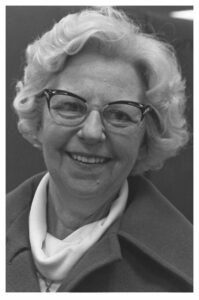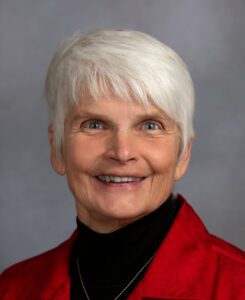Click the Image to Learn about Our A-mazing Members
 Florence Kendall (1910-2006)
Florence Kendall (1910-2006)
From the Biography written by Richard Behles
Born in Warman, Minnesota on May 5, 1910 as Florence May Peterson, she was the eleventh child of Swedish immigrants Charles August and Mathilda Kruse Peterson. One month after her sixteenth birthday, Florence Peterson graduated as valedictorian from her high school in Mora, Minnesota. Following that, she advanced to the University of Minnesota, where she subsequently earned her Bachelor of Science degree in Physical Education in June, 1930. After a year teaching Physical Education in her native Minnesota, Florence ventured south to study physical therapy at the Walter Reed Army Hospital in Washington, DC, beginning there in September, 1931. While she was at Walter Reed, one of Florence’s assignments was providing supplementary treatment for a young boy stricken with polio, who was a patient at the Children’s Hospital in Baltimore under the care of the noted physical therapist Henry O. Kendall. On May 5, 1933, Florence and some of her colleagues visited Children’s Hospital to hear Henry Kendall deliver a lecture. Although they had been distant partners involved with the same case for quite some time, this was the first occasion on which Florence and Henry met face-to-face. Her stint as an assistant at Walter Reed was a short one, however, as Florence was among the victims of budgetary staff cuts, experiencing her own severance from the hospital on May 15, 1933. Fortunately, after only a few brief months, Florence returned once again to Children’s Hospital in Baltimore, this time to accept a position on its staff. While she couldn’t have known it at the time, that change would represent the most profound boost to her personal and professional life, an advancement far exceeding anything she ever could have imagined. Florence began working under Henry Kendall’s direction in July 1933. In just a year and a half, they were married.
| “By the time I arrived at Children’s Hospital, Mr. Kendall had already established himself in the field with his treatment of patients with polio and low back pain. Our work did not evolve out of ambition, but more out of a sense of responsibility. When people referred to us as mentors and role models, I always considered it a privilege to serve in these roles.” 2 |
That sentiment remained the hallmark of the Kendalls’ work throughout their entire professional lives. Within just a few years, Henry and Florence co-authored U.S. Public Health pamphlets based on their studies of muscle evaluation and treatment procedures for polio patients. Their earliest publications also included 16 mm demonstration films. They rose to faculty positions at the University of Maryland and Johns Hopkins University soon thereafter, and remained in those posts for decades. In the early 1930’s, the Kendalls represented one half of Maryland’s four-person membership in the American Physiotherapy Association. The Association’s national headquarters attempted to persuade them to establish a chapter in the state.
In the early 1930’s, the Kendalls represented one half of Maryland’s four-person membership in the American Physiotherapy Association. The Association’s national headquarters attempted to persuade them to establish a chapter in the state. Eventually in 1939, Henry and Florence agreed to the effort. Hesitant at first with their young family beginning to grow, Florence gave in to the enthusiasm of other members who urged her to serve as the first president of the new Maryland chapter.
Henry and Florence continued their work on many fronts, including state legislation. It was due to their efforts that the Maryland state legislature enacted into law a 1947 bill that legally established the professional practice of physical therapy. Following that landmark development at the state level, Henry and Florence sought to share their expertise with the national audience. They published the first edition of their book MUSCLES : TESTING AND FUNCTION in 1949. Based primarily on their extensive work in polio research, the book set a whole new standard of detail for musculoskeletal examination and treatment. Their companion title POSTURE AND PAIN followed in 1952, in which they reported on their study of 12,000 cases to illustrate and diagnose numerous diseases and other painful conditions associated with faulty body mechanics and alignment.
| “We didn’t write the books to be famous. We wanted to share with others what we had learned in all our work with polio, posture, and painful conditions, especially low back pain. With both of us working full time, it was not an easy task to write a book; however it had to be done. It was bigger than either of us, but we were dedicated to sharing what we had learned.” 3 |
Such was the measure of their concern for the better health and welfare of the world. A few years after the appearance of MUSCLES: TESTING AND FUNCTION, the Kendalls made the very difficult decision to leave Children’s Hospital and set out on their own in private practice. Following this move, they no doubt were the principal inspiration for the APTA to create its new Self-Employed Section a few years later. APTA Maryland honored Florence and Henry in 1976 by establishing the Henry O. and Florence P. Kendall Award for Outstanding Achievement in Clinical Practice.
In the ensuing years, Florence’s dogged perseverance kept her at the head of the profession, as she continued her writing, teaching, and delivering guest lectures at countless workshops around the country. As a registered parliamentarian, Florence assisted in drafting bylaws for the APTA at both the state and national levels. Florence received the Lucy Blair Service Award in 1971. She went on to deliver the 1980 Mary McMillen Lecture, and later became a Catherine Worthingham Fellow in 1986. She was the APTA’s John H. P. Maley lecturer in 1997. The University of Maryland School of Medicine awarded Florence an honorary doctorate in 1999, topping off three others she’d already received from the University of Indianapolis, the Philadelphia College of Pharmacy and Science, and Shenandoah University.
Florence maintained her enthusiasm, dedication, and busy schedule well into her nineties. Her life of service came to its conclusion when she died on January 28, 2006 at the age of ninety-five.
| Dedicated, unflappable, and always a revered icon, mentor, and friend to countless numbers of students and colleagues, Florence Kendall in person and in print surely taught, energized, and most especially inspired an entire profession of competent and knowledgeable Physical Therapy practitioners. |
REFERENCES
1. Florence P. Kendall Biography. The biography by Richard Behles was originally written for the Historical Collections Department Website. It describes the life of Florence Kendall and her career.
2. Florence Kendall, “Florence Kendall: What a wonderful journey”, by Lucie P. Lawrence, PT MAGAZINE, VOL. 8 #5 (May 2000), p. 41.
3. Florence Kendall, “Florence Kendall: What a wonderful journey”, by Lucie P. Lawrence, PT MAGAZINE, VOL. 8 #5 (May 2000), p. 42.
 Carol Hamilton Zehnacker PT, DPT, MS was an inspired professional, a tenacious individual and a compassionate human being.
Carol Hamilton Zehnacker PT, DPT, MS was an inspired professional, a tenacious individual and a compassionate human being.
She was a member of the APTA for 56 years and served our profession in many ways at both the state and national levels as a leader, mentor, and advocate. She received her degree in Physical Therapy from Duke University and her Doctor of Physical Therapy from Widener University.
Dr. Zehnacker’s business skills and devotion to healing through physical therapy led her to found Amber Hill Physical Therapy in 1985. After fifteen years she sold the business, freeing her to pursue a Doctorate in Physical Therapy from Widener University in Chester, Pennsylvania. It was after this time that she began to see clients in their homes and later, at her own home.
She demonstrated a steadfast commitment to the profession with not only her personal time and efforts through the years as an APTA member but with her dedication to her various roles within APTA Maryland. Carol was a delegate in the APTA House of Delegates for many years and served as Chief Delegate, Director of Government Affairs, Western District Chair, Federal Affairs Liaison, and Director for Reimbursement.
At the state level, Dr. Zehnacker served for ten years on the Maryland Physical Therapy Board of Examiners. At the national level, she served as the Federal Affairs Liaison and Government Affairs Committee Chair for the Home Health Section. In this role she advocated fiercely against administrative burden and regulations that hamper PTs ability to provide quality care which can lead to provider burnout.
Dr. Zehnacker has been acknowledged by her colleagues for outstanding service to the profession of physical therapy and has been awarded the APTA Maryland Henry O. and Florence P. Kendall Awardee in 2005; the Richard T. Peret Distinguished Service Award in 2018; the Stephen Levine Award in 2019; and, by APTA with the 2021 Lucy Blaire Service Award.
Carol was an active participant in the community life of Frederick, MD. While maintaining her practice and teaching responsibilities, she served the Women’s Giving Circle and on the Board of Directors of Heartly House for Victims of Domestic Violence.
Many members will tell you that Carol was the first to welcome them to the Maryland Chapter and the profession. Friends and colleagues will tell you that Carol was passionate, entertaining, inspiring, and a champion for the profession and tireless advocate for her patients.
Carol passed away on November 21, 2021 after battling Amyotrophic Lateral Sclerosis – Lou Gehrig’s Disease. Always striving to care for others, she continued to see patients in her home until she physically was no longer able.
APTA MARYLAND